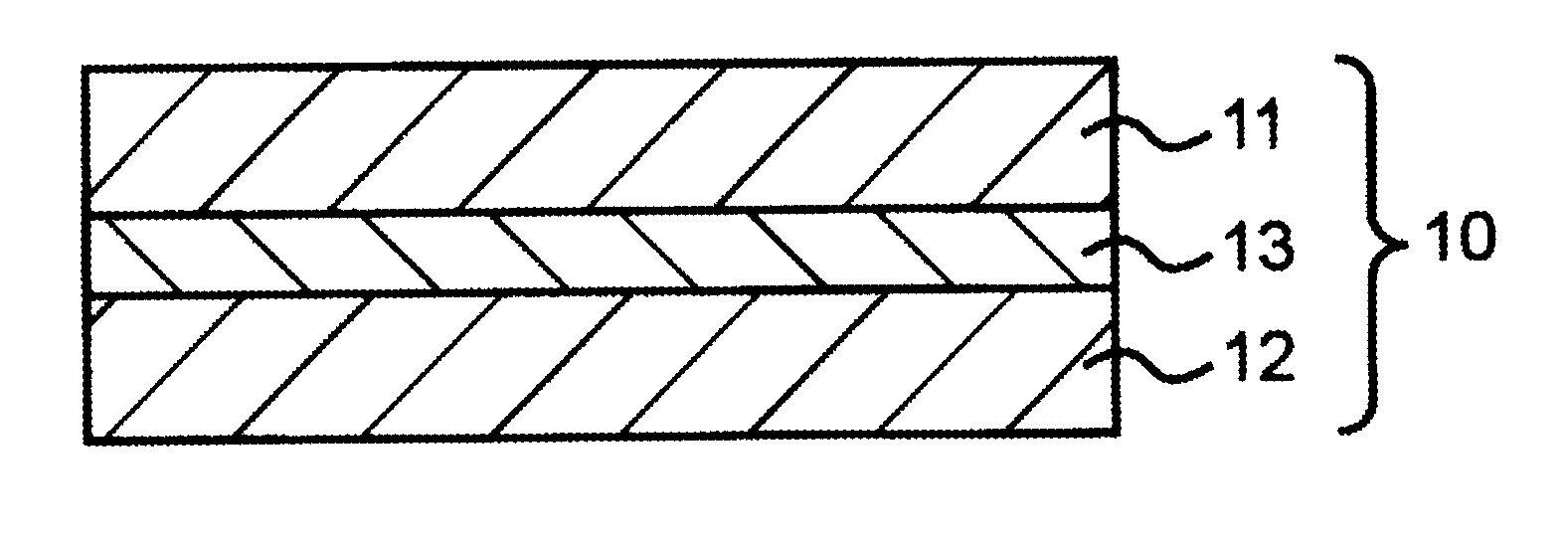Protective sheet for rear surface of solar cell
a solar cell and rear surface technology, applied in the direction of adhesives, semiconductor devices, adhesive types, etc., can solve the problems of poor adhesion of materials, inability to provide sufficient adhesion strength, etc., to suppress the appearance of solar cell modules, suppress zipping, and good adhesion strength
- Summary
- Abstract
- Description
- Claims
- Application Information
AI Technical Summary
Benefits of technology
Problems solved by technology
Method used
Image
Examples
example 1
[0043]A linear low-density polyethylene (LLDPE) resin composition was prepared by adding 25 kg of titanium oxide particles to 100 kg of a polyethylene resin with a density of 0.91 g / cm3 and sufficiently kneading the mixture. This LLDPE resin composition was extruded with an extruder to obtain an inner layer substrate with a thickness of 50 μm.
[0044]A polyethylene terephthalate film with a thickness of 250 μm (produced by Toyobo Co., Ltd.; Toyobo ester film E5102) was prepared as an intermediate layer substrate having excellent electrical insulation.
[0045]A PVF film (produced by DuPont, 38 μm) was prepared as an outer layer substrate.
[0046]As an adhesive, a urethane resin was obtained by mixing 7.8 parts by weight of Lexp 11-1, an isocyanate compound produced by Henkel Japan Ltd. (containing a xylylene diisocyanate monomer in an amount of 30 parts by weight and hexamethylene diisocyanate isocyanurate in an amount of 70 parts by weight; the NCO group percentage is 28.7%), with 100 par...
example 2
[0048]A solar cell rear surface protection sheet was obtained in the same manner as in Example 1 except that Lexp 10-4 produced by Henkel Japan Ltd. (using 10 parts by weight of acrylonitrile instead of 5 parts by weight as in Lexp 10-3) was used as an acrylic polyol.
example 3
[0049]A solar cell rear surface protection sheet was obtained in the same manner as in Example 1 except that Lexp 10-5 produced by Henkel Japan Ltd. (using 15 parts by weight of acrylonitrile instead of 5 parts by weight as in Lexp 10-3) was used as an acrylic polyol.
PUM
| Property | Measurement | Unit |
|---|---|---|
| glass transition temperature | aaaaa | aaaaa |
| hydroxyl value | aaaaa | aaaaa |
| thickness | aaaaa | aaaaa |
Abstract
Description
Claims
Application Information
 Login to View More
Login to View More - R&D
- Intellectual Property
- Life Sciences
- Materials
- Tech Scout
- Unparalleled Data Quality
- Higher Quality Content
- 60% Fewer Hallucinations
Browse by: Latest US Patents, China's latest patents, Technical Efficacy Thesaurus, Application Domain, Technology Topic, Popular Technical Reports.
© 2025 PatSnap. All rights reserved.Legal|Privacy policy|Modern Slavery Act Transparency Statement|Sitemap|About US| Contact US: help@patsnap.com


